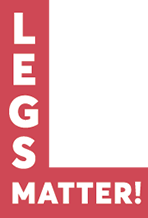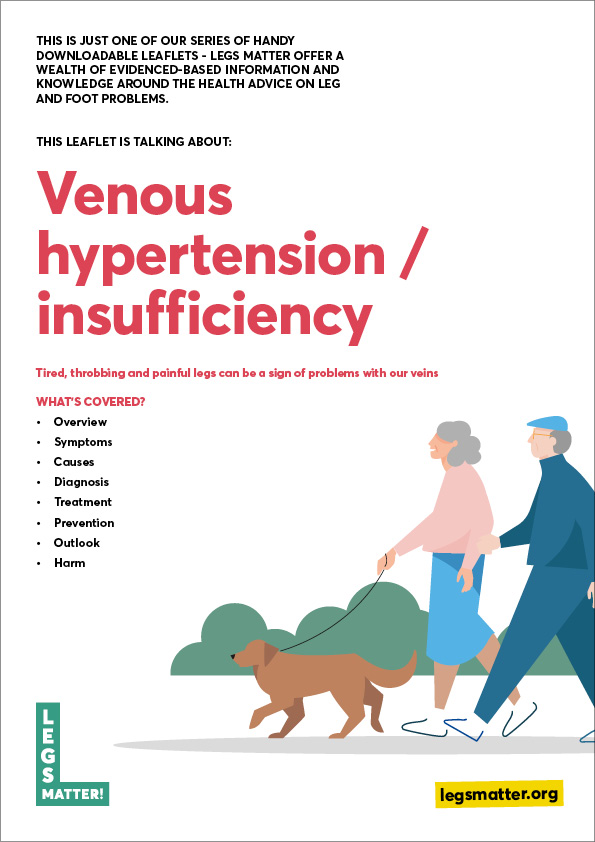Overview – how venous hypertension / insufficiency can lead to having problems with leg ulcers
Sometimes our legs get tired and ache. However, tired, throbbing, painful legs can be early signs of venous hypertension / insufficiency.
Symptoms of venous hypertension
You may experience heavy feeling in your legs, swelling, pain and tenderness. Some people also complain of restless legs and varicose veins.
Causes – what can cause tired throbbing painful legs?
Venous hypertension / insufficiency can cause tired throbbing painful legs
Tired, throbbing and painful legs might be connected to problems with the veins in our lower legs. Blood is pumped from our heart to the rest of our body through our arteries. It returns to our heart through our veins. Our blood is propelled back to our heart by our heart pumping and by our leg and foot muscles as we walk and move our ankles.
Our veins contain one-way valves to stop the blood falling back towards your toes. These valves can become weak or damaged. When this happens, our veins become so swollen (varicose veins) that blood is forced into the tissue of our skin making it swell. This can make our legs feel tired, throbbing and painful. You may notice that your ankles swell, especially in the evening. This is because blood is forced into the tissue of your skin.
Diagnosis – getting diagnosed with venous hypertension
If your legs feel tired, throbbing and painful, make an appointment at your GP practice. You may be given an appointment to see the nurse rather than the doctor as nurses are often responsible for caring for patients with leg problems.
Alternatively, there might be a Leg Club or specialist leg clinic in your area. You don’t need to be referred by your GP to visit these clinics.
When you see the nurse or doctor, they should:
- Ask about your symptoms and how long you have had problems
- Examine your lower legs
You may also be offered a simple test called an Ankle Brachial Pressure Index (ABPI). This test measures the blood pressure in your ankle and compares it to the pressure in your arm to see if you have problems with the arterial blood supply to your lower leg.
You might also be offered some further tests to check for other health problems that can affect your legs, such as diabetes and anaemia
If your GP practice thinks that your pain is caused by problems with your veins or arteries, they may refer you for further tests at your local hospital or specialist clinic.
Treatment – what treatment will I be offered for venous hypertension?
Compression therapy (support bandages or socks)
If your pain is caused by venous insufficiency, and there are no problems with the arterial blood supply to your legs, then you must be offered compression therapy.
Compression therapy improves the venous blood supply back to the heart by applying pressure to the leg. This can be done by bandaging the lower leg or by wearing supportive socks, stockings or tights. Compression therapy is very effective at reducing swelling and healing or preventing sores or ulcers. There are lots of different types of compression therapy so ask your nurse to find something that is right for you. Compression can be a little uncomfortable when you first start treatment but any discomfort should reduce as the swelling goes down. You might find it helpful to take pain killers when you start compression therapy.
Venous intervention
If your problems / symptoms are caused by venous hypertension there are simple interventions available on the NHS to treat the veins which are not working correctly, therefore, providing a permanent solution to your issues. If the issues are believed to be coming from your veins you should seek a referral through your GP / healthcare practitioner to your local vascular specialist team.
The most common vein treatment options available include:
- Endothermal ablation – where heat is used to seal up the affected veins
- Sclerotherapy – this uses special foam to close the veins
- Ligation and stripping – where the affected veins are surgically removed
Healthcare advice for venous hypertension
Making healthy changes to your lifestyle can help reduce the symptoms of tired, throbbing, painful legs:
- Maintain a healthy weight
- Take light to moderate exercise, such as swimming or walking for about 30 minutes at least three times a week
- Avoid standing for a long time
- Wear compression socks or tights instead of ordinary socks / tights
Prevention of venous hypertension
There are several things you can do to avoid getting venous hypertension:
- Maintain a healthy weight
- Take light to moderate exercise, such as swimming or walking for about 30 minutes at least three times a week
- Avoid standing for a long time
- Wear compression socks or tights instead of ordinary socks / tights
The outlook for venous hypertension
It is important that you work together with your Nurse or helath care provider to ensure you get the best outcomes from your treatment.
With compression hosiery and following the directions above the outlook is good
Harm – the risk factors for venous hypertension
- Not performing a vascular assessment to determine if suitable for compression
- Not using compression if indicated can lead to worsening disease
- Not being referred to vascular services for venous intervention if indicated
Venous hypertension downloadable leaflet (PDF)
We’ve created a handy downloadable leaflet of the key information on this page so you can easily print it out for personal reference or to hand to a patient or healthcare professional. Or you can also simply forward it on by email.
Other support
Some organisations you can contact for further information.
Accelerate Based in East London, Accelerate can accept national referrals from your GP / specialist to our world-class centre where we pioneer and trial experimental new treatments for chronic leg ulcers / wounds, lymphoedema and mobility challenges.
Contact details
020 3819 6022
hello@acceleratecic.com
Find out more on the Accelerate website
The Lindsay Leg Club Foundation Promoting and supporting community based treatment, health promotion, education and ongoing care for people who are experiencing leg-related problems - including leg ulcers and other wound care issues.
Contact details
01473 749565
lynn.bullock@legclubfoundation.com
Find out more on the Lindsay Leg Club Foundation website
The Circulation Foundation The Circulation Foundation is the UK’s only dedicated vascular charity. They fund and promote research into the causes, treatment and prevention of vascular disease.
Contact details
020 7205 7151
info@circulationfoundation.org.uk
Find out more on The Circulation Foundation website
NHS Choices the official NHS website, which provides vital information and support about leg and foot signs and other symptoms.
Contact details
Call 111 - for non-emergency medical advice
Find out more on the NHS Choices website
Tell us what you think
If there’s anything you want to ask us or tell us, whether it’s a suggestion about our website, a complaint, or a compliment, drop us a line at
support@legsmatter.org










